Oval vs Round Diamond Engagement Rings: Key Differences
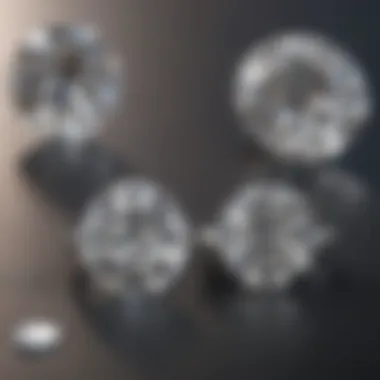
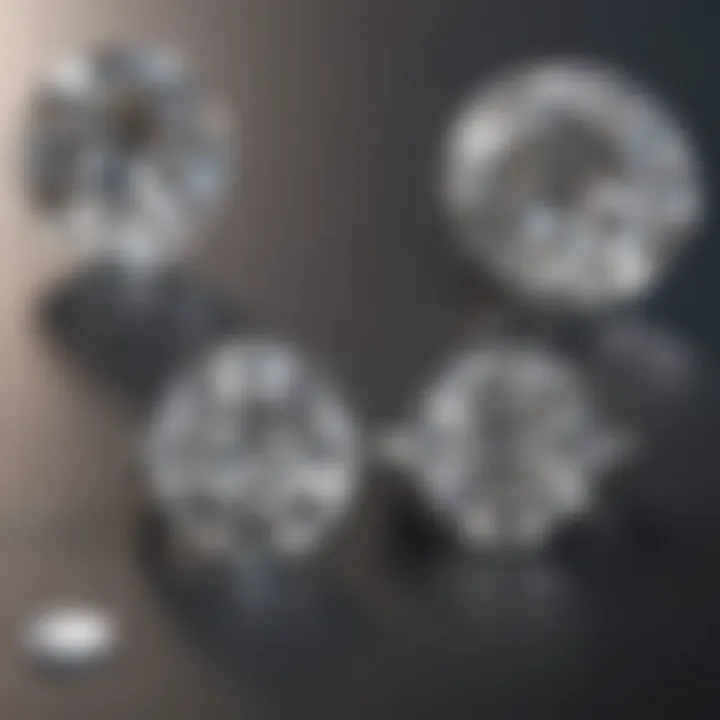
Intro
When embarking on the journey of selecting an engagement ring, few decisions are as impactful as the shape of the diamond. Among the myriad of options available, oval and round diamonds stand out due to their timeless aesthetic and cultural significance. Understanding the nuances between these two shapes can empower buyers to choose a ring that resonates with their style and love story. This comparative analysis will delve into the unique attributes of both oval and round diamond engagement rings, ensuring that those in the market can navigate their choices with clarity and confidence.
Gemstone Overview
Definition and Origins
Diamonds have fascinated humanity for ages, but the specific shapes we find today have their own journeys. A round diamond, traditionally the most sought after, is cut in a circular shape that maximizes its brilliance. This cut is derived from centuries of artistry in lapidary work. On the other hand, the oval diamond emerged much later but has become increasingly popular among modern couples seeking something slightly different yet still classic.
Historical Significance
The round cut can trace its lineage to the early 20th century, thanks to the work of Marcel Tolkowsky, whose innovations laid the groundwork for what we now recognize as the ideal cut. *. The oval cut, created after this, gained popularity in the late 20th century as more individuals sought unique alternatives to traditional styles. Each shape tells its own story, reflecting the evolving preferences in the realm of engagement rings throughout history.
Gemstone Properties
Hardness and Durability
Both oval and round diamonds boast remarkable hardness, rated at a perfect 10 on the Mohs scale. This quality makes them suitable for everyday wear. However, the oval's elongated shape can sometimes make it more susceptible to chipping if not set properly. Proper settings become crucial to ensure great durability for oval diamonds, whereas round diamonds, with their symmetrical design, tend to distribute pressure more evenly.
Color and Clarity
When it comes to visibility of color and clarity, there are some intriguing distinctions. Round diamonds tend to reflect light through their multiple facets, often masking inclusions and enhancing clarity. On the contrary, ovals may display their internal structures differently due to their varying proportions. Generally, choosing a colorless or near-colorless diamond is advisable for both shapes to achieve optimal brilliance.
"Choosing the right diamond is as much about the physical attributes as it is about the emotional connection. Each shape captures light and spirit differently."
Key Points to Consider:
- Round diamonds are highly versatile and often preferred for traditional settings.
- Oval diamonds can create a perceived longer finger appearance and may appear larger than their carat weight suggests.
- Establish a balance between personal stylistic preferences and the inherent properties of these beautifully crafted gems.
Culmination
In exploring the world of oval and round diamonds, one does not simply chalk up decisions to shape alone. Historical context, physical properties, and personal tastes intertwine to form a clearer picture of what may truly speak to an individual’s heart. This exploration lays the groundwork for potential buyers to feel informed and confident in their engagement ring journey.
Prelude to Engagement Ring Shapes
Choosing an engagement ring can feel like a Herculean task, especially with so many designs vying for attention. The shape of the diamond is often the centerpiece of this choice, serving as a canvas that reflects the personality and elegance of the wearer. Understanding engagement ring shapes is not merely an aesthetic consideration; it’s an integral part of what makes the ring special and significant. This section aims to dissect the essence of diamond shapes and illuminate their roles in the realm of jewelry, particularly focusing on round and oval forms.
There’s much more than meets the eye when it comes to diamond shapes. An engagement ring is a symbol of commitment, love, and shared moments. The shape you choose speaks volumes. Each shape expresses different styles and sentiments, aligning or contrasting with personal tastes or lifestyle choices. It’s essential to recognize that the shape can affect the perceived size, sparkle, and even the overall elegance of the ring.
The diamond’s shape is often the first consideration for buyers. If someone shopping for an engagement ring has their heart set on a specific shape—be it round, oval, or any other they envision—they're more likely to feel satisfied and proud wearing that piece. Making such decisions based on informed perspectives opens a door to broader discussions about popularity, cultural connotations, and personal preferences. In fact, the shape can dramatically influence a ring's ability to complement different settings and styles, further showcasing its importance.
"The right engagement ring shape can amplify not just the ring’s physical beauty but also its emotional weight."
Significance of Shape in Diamond Selection
When it comes to selecting a diamond, shape sits at the pinnacle of the decision-making process. The shape of a diamond can influence not only its visual impact but also the emotions it invokes. Here are a few noteworthy elements that make it significant:
- Personal Expression: A diamond's shape can resonate with one’s character. Round diamonds encapsulate classic elegance, while ovals can hint at a modern twist, appealing straightaway to contemporary sensibilities.
- Visual Illusion: Different shapes possess unique qualities that affect how the diamond is perceived. For instance, ovals can create an illusion of elongated fingers, while round cuts are often associated with timeless beauty and brilliance.
- Trends and Symbolism: Certain shapes may carry historical or cultural significance, revealing much about not just the wearer but familial legacies or cultural traditions.
- Setting Compatibility: The chosen shape easily influences how the diamond integrates into various settings. A round diamond may shine brightly in a simple solitaire, while an oval may shine in elaborate designs, marrying perfectly with intricate filigree.
Embracing the many facets of engagement ring shapes, particularly the round and oval, allows potential buyers to navigate the intricate landscape of diamond selection with confidence. With a fundamental understanding of what each shape represents, couples can embark on the journey of engagement ring shopping with clarity, vision, and a deeper appreciation for the craft behind their chosen piece.
Understanding the Round Diamond
When discussing diamond engagement rings, the round shape often comes to mind first. This is more than just a popular choice; it's a standard in the jewelry world for various reasons. First off, round diamonds are recognized for their versatility. They can fit seamlessly into a range of settings and styles, appealing to diverse tastes and preferences. Moreover, the round shape is particularly renowned for its ability to maximize brilliance and fire, making it an intriguing selection for anyone captivated by sparkle.
Another noteworthy aspect of round diamonds is their historical significance. Having been in vogue for centuries, these stones carry a legacy unmatched by other shapes. Their consistent popularity leaves a mark on both personal choices and industry standards. Understanding the evolution and appeal of round diamonds provides a backdrop to why they often outshine their oval counterparts, especially for first-time buyers or those with traditional viewpoints.
Historical Overview
The journey of the round diamond begins with its historical roots. First cut in the late 17th century, with the brilliant cut emerging in the early 20th century, round diamonds have continually evolved. The creation of the modern round brilliant cut by Marcel Tolkowsky in 1919 marked a pivotal moment in the diamond industry. This cutting technique focused on maximizing light reflection and creating that coveted sparkle.
In the years following, round diamonds gained prominence, especially in engagement rings. They became synonymous with elegance, romance, and timelessness. The traditional "solitaire" setting, with a single round diamond centerpiece, quickly became the go-to choice for many couples.
Brilliance and Fire
What truly sets round diamonds apart is their impressive ability to reflect light, creating brilliance and fire that can literally catch the eye from across a room. The round shape is designed with 58 facets which work in unison to refract light perfectly. This aspect is not only vital for aesthetic purposes but also impacts how the diamond is perceived under various lighting conditions.
Customers often prioritize these attributes when shopping for gems. The phenomenon of brilliance and fire is so pronounced that many non-experts can still appreciate it. When you hear someone say a diamond seems to sparkle more dramatically, they're likely referring to a round diamond. This optical performance is crucial in validating its high regard in the market.
Popularity in Modern Jewelry
Despite the emergence of various styles, the round diamond remains a top pick in the jewelry industry. The statistics speak volumes: roughly 75% of diamond sales are attributed to round shapes. This phenomena reflects not just preference for aesthetics but also a certain reliability tied to its longstanding reputation.
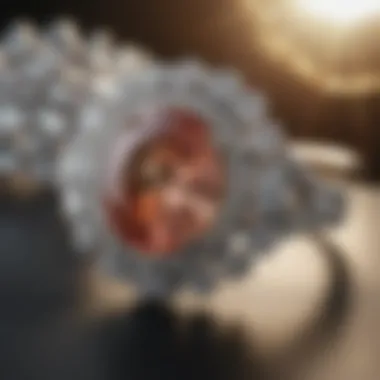
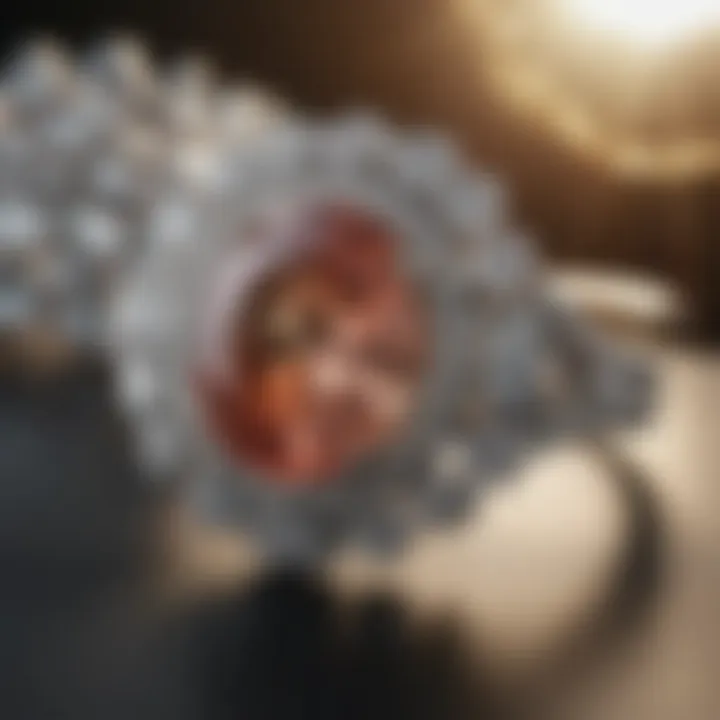
Factors contributing to its popularity include:
- Timeless elegance: Round diamonds function well in both classic and modern settings.
- Versatility: Perfect for any occasion, from weddings to anniversaries.
- Recognized standard: Familiarity plays a significant role—everyone knows what a round diamond looks like.
For jewelry designers, these factors open a treasure trove of possibilities to create stunning pieces while catering to the demands of consumers. Round diamonds continue to shine brightly in a world where personal taste can be as diverse as the stars in the sky.
"Round diamonds not only hold history but showcase a brilliance that remains unmatched by any other shape."
In summary, understanding the round diamond is essential for anyone contemplating an engagement ring purchase, whether for the sentiment attached or the heritage of the stone itself. Its blend of history, aesthetic appeal, and versatility makes it a cornerstone in the realm of fine jewelry.
Exploring the Oval Diamond
Diving into the world of oval diamonds brings forth a perspective that enhances the overall understanding of engagement rings. When selecting a gemstone, the shape plays a pivotal role in both its visual impact and its emotional connection for the wearer. The oval diamond, with its distinct elongated form, possesses attributes that differentiate it from other shapes, capturing attention in a unique manner. Highlighting these characteristics not only broadens the knowledge base of potential buyers but also fosters appreciation for the versatility that the oval shape offers.
Origin and Evolution
The oval diamond has a fascinating history that dates back to the late 1950s when the legendary gemologist Marquise de Pompadour crafted the first oval cut, with the design aimed at maximizing brilliance. It took inspiration from the shape of an egg, aiming to create a stone that was both elegant and striking. Over time, this cut evolved, gaining prominence in the jewelry market due to its clever balance of size and sparkle.
Interestingly, the oval's development was not just a matter of aesthetics. It was designed specifically to hide inclusions and enhance perceived size. This cut can appear larger than a round diamond of the same carat weight because of its elongated silhouette. Consequently, the blending of functionality with design has made the oval diamond a cherished choice across generations.
Unique Characteristics
What sets oval diamonds apart is their long and narrow form, which creates a mesmerizing optical effect. The unique shape can contribute to an illusion of length in the fingers, making it a favorite for those who appreciate a bit of flair. Furthermore, the oval cut exhibits a phenomenon known as the "bow tie effect," where darkness appears in the center, resembling a bow tie when viewed from above. This character can be a double-edged sword; while some may view it as a charming feature, others might prefer more uniform brightness.
- Brilliance: Oval diamonds generally reflect light brilliantly, producing a sparkle reminiscent of their round counterparts.
- Versatility: This shape pairs well with various settings, from classic solitaires to intricate halo designs.
- Personalization: The oval diamond allows for a creative array of options in terms of ring settings and styles.
Trending in Engagement Rings
Recent years have seen a shift in consumer preferences, marking the oval diamond as a trending choice in engagements. Celebrities, influencers, and tastemakers have donned oval-shaped rings, effectively paving the way for broader acceptance and appreciation among the general public. The sparkly allure combined with its unique silhouette taps into the desire for something both elegant and slightly out of the ordinary.
In fact, searches related to oval diamonds have increased significantly, reflecting a growing fascination. Couples looking for an engagement ring that stands out without veering too far from classic elegance often gravitate toward the oval cut. Additionally, the versatility in styling makes it suitable not just for engagements but as an investment piece that can adapt to various occasions.
As the diamond landscape continues to evolve, the oval diamond will undoubtedly remain a frontrunner in the quest for beauty and individuality.
Cut and Quality Comparison
In the realm of diamond engagement rings, the cut and quality are not just technical specifics; they're pivotal in determining the ring's overall aesthetic appeal and brilliance. When considering either oval or round diamonds, understanding these aspects can serve as a reliable compass in your decision-making process. It’s not merely about which shape looks nicer; it’s about how well the diamond captures light, radiates fire, and complements the metal setting. By delving into the nuances of diamond cuts and their quality, this section aims to equip potential buyers with key insights that stand the test of time.
Understanding Diamond Cuts
The term "cut" refers to how a diamond is shaped and faceted from its original rough form. This aspect encompasses more than just the physical shape of the diamond. It involves assessing the diamond’s proportions, symmetry, and polish. For any diamond, the cut is paramount because it greatly influences how light travels through the stone.
- Proportions: Ideal cut diamonds exhibit precise proportions that optimize brilliance. For both oval and round diamonds, a well-cut stone can enhance its appearance significantly.
- Symmetry: This term describes how evenly the facets are aligned. For instance, in a round diamond, perfect symmetry helps in achieving maximum fire and light return. Conversely, in oval diamonds, symmetry can impact the perception of length and width, an essential element for their visual appeal.
- Polish: This refers to the surface condition of the diamond. A high-quality polish reflects light beautifully, adding to the ring's allure.
Evaluating Cut Quality
Not all cuts are created equal. The quality of the cut plays a crucial role in determining a diamond's visual performance. When shopping for either an oval or round diamond, consider these key elements:
- Light Performance: Engaging a diamond's life is all about how it refracts light—this factor can be drastically different between two stones of the same cut grade.
- Certification: Reputable grading agencies like the GIA (Gemological Institute of America) and AGS (American Gem Society) offer detailed cut grades. Pay close attention to these grades for peace of mind.
- Personal Preference: Some individuals might prefer the elongated shape of an oval diamond, while others might favor the classic round. Thus, evaluating cut quality also involves understanding personal taste and how it aligns with the diamond’s attributes.
Expert Ratings and Recommendations
When it comes to diamonds, having insights from professionals can steer buyers in the right direction. Experts often evaluate diamonds based on a combination of factors that inform their overall quality:
"A diamond’s allure is often determined by its brilliance, and this largely comes down to the cut."
- Round Diamonds: Generally, this shape is known for achieving optimal light performance due to its traditional cutting styles. Look for round diamonds with Excellent or Ideal cut grades.
- Oval Diamonds: Though they are an elegant alternative, ensure they exhibit similar quality standards as round diamonds. An oval with a great cut will shine as brightly, so prioritize symmetry.
- Recommendations: If your heart is set on a specific shape, consult with jewelers who can guide you based on your preferences and the diamond's characteristics.
In sum, the assessment of cut and quality is a central pillar in choosing between oval and round diamond engagement rings. A thorough understanding not only amplifies your appreciation for the gem but also ensures that your choice aligns with both your personal style and the stone's inherent beauty.
Aesthetic Considerations
When it comes to engagement rings, aesthetics play a pivotal role in selection. Beyond the cut and clarity of the diamond itself, how the shape interacts with light, setting, and even personal style can't be overstated. Both oval and round diamonds bring unique flair to the table, affecting the overall visual appeal of the ring.
Visual Appeal of Round Diamonds
Round diamonds are nothing short of a classic. Their shape captures light in a way that seems almost magical, maximizing brilliance and fire. Some might argue it's like a dance of twinkling stars, mesmerizing to the observer. This effect stems from the ideal cut that round diamonds typically have. They require precise angles and proportions, allowing them to reflect light beautifully.
From a traditional perspective, round diamonds embody a timeless elegance. They’ve been the reigning choice for decades, often seen in family heirlooms and grand proposals that echo with sentiment over time. The clean lines and symmetry of the round shape can complement any type of jewelry setting and personal style. You're covering a wide ground; whether it be subtle or extravagant, the round diamond seems to adapt well.
Charm of Oval Diamonds
In contrast, oval diamonds have a charm that’s hard to resist. Their unique elongated shape creates an illusion of size, making even smaller carat weights appear more substantial. It's a well-kept secret among buyers looking for a bigger impact without breaking the bank. The silhouette is elegant, giving a touch of modernity while still holding on to a classic feel.
The oval shape's flexibility in settings is also worth noting. Unlike round diamonds, which typically look best in classic prong settings, oval diamonds can pull off a wide array of styles, from simple solitaires to intricate halo designs. This versatility can speak volumes about the wearer’s character and individuality, which is significant in a piece that’s meant to symbolize love and commitment.
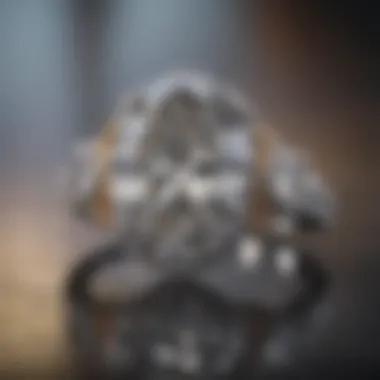

Comparison of Wearability
When comparing the wearability of these two shapes, several factors come into play. Round diamonds often sit snugly in virtually any setting, making them practical for everyday wear. This is ideal for active lifestyles.
Oval diamonds, however, are not without their considerations. The elongated shape can sometimes catch on clothing or snag easily if not set properly. Still, many find this minor flaw outweighed by the aesthetic advantages. Here's a quick comparison:
- Round Diamonds
- Oval Diamonds
- Pros: Timeless, versatile, excellent brilliance.
- Cons: Can be considered too traditional by some.
- Pros: Unique look, affordable size illusion, flexible in settings.
- Cons: May require careful setting to prevent snagging.
In the end, both shapes present beautiful options. Personal taste and lifestyle should guide the decision-making process.
It’s a fine dance between tradition and modernity, brilliance and charm, practicality and style. Whether one's heart is set on a classic round or an alluring oval, what matters most is the story the ring signifies—love, commitment, and the journey ahead.
Settings and Styles for Engagement Rings
When selecting an engagement ring, the setting and style hold as much weight as the diamond itself. The right combination can enhance the ring's beauty significantly, conveying a unique personality and sentiment attached to the piece. For many, it’s not just about the diamond; it’s about how that diamond speaks to their individual taste. A thoughtful choice can elevate the aesthetic appeal while ensuring the piece is practical for everyday wear. Understanding the different settings and styles also permits buyers to consider factors like durability, maintenance, and versatility.
Popular Setting Types for Round Diamonds
Round diamonds hold a significant spot in the world of engagement rings, often paired with classic settings that highlight their brilliance. Here are some popular settings:
- Solitaire Setting: This is where a single round diamond takes center stage, often sitting high on the band. This style makes the diamond look even larger and captures maximum light, amplifying its sparkle.
- Pavé Setting: A classic choice featuring a band adorned with small diamonds closely set together. This creates a seemingly limitless sparkle that perfectly complements a round diamond.
- Halo Setting: In this setting, a circle of smaller diamonds surrounds the larger round one, enhancing its visual size. It significantly increases brilliance and adds a touch of glamour.
- Three-Stone Setting: This design features three stones, typically representing the past, present, and future. A round diamond in the center flanked by two smaller stones often creates a rich story.
These popular settings cater to varied tastes, from contemporary to timeless designs, making the round diamond shine like no other.
Best Settings for Oval Diamonds
Oval diamonds, with their elongated shapes, offer unique opportunities for setting. Their silhouettes can make fingers appear longer, and selecting the right setting is paramount:
- Classic Solitaire: Similar to round diamonds, ovals also look stunning in a solitaire setting, emphasizing the shape and brilliance of the stone without distractions.
- Tension Setting: A modern approach where the oval is held in place by the tension of the band. This minimalist setting creates a striking illusion of the diamond floating.
- Side Stone Setting: Adding smaller diamonds or colored gemstones alongside an oval can create a beautiful contrast, enhancing the overall appearance and ensuring that the oval remains the star of the show.
- Vintage Inspired: Oval diamonds fit beautifully in vintage designs that often feature intricate detailing and ornate craftsmanship, providing both old-world charm and modern flair.
Choosing the right setting for an oval diamond can amplify its beauty and make a bold statement.
Impact of Setting on Overall Look
The impact of a ring’s setting on its overall appearance cannot be overstated. Here are a few ways how the setting shapes the ring:
- Brilliance and Sparkle: The right setting can dramatically increase a diamond’s brilliance. For example, a halo setting maximizes light reflection, creating a dazzling effect compared to simpler styles.
- Finger Length Perception: Certain shapes and settings can create an illusion of longer fingers. Oval diamonds, when set in a way that emphasizes their shape, can contribute to this effect.
- Versatility and Layering: The chosen setting can determine how easily you can pair the ring with other bands or rings for future occasions. Settings that allow for stacking can add more complexity and style to a jewelry collection.
- Personal Expression: Lastly, every engagement ring is a statement of love and commitment. The setting can act as a personal signature, reflecting the wearer's taste and style.
"An engagement ring not only symbolizes commitment but also offers a glimpse into the personality of the wearer. The choice of setting plays a crucial role in conveying that message."
These considerations illustrate that the setting and style of an engagement ring are not just practical choices but also emotional expressions. Understanding how to skillfully combine these elements ensures a meaningful and beautiful gift.
Cultural Significance and Symbolism
Understanding the cultural significance and symbolism of engagement rings, specifically in the context of round and oval diamonds, unveils layers of meaning that have evolved over centuries. The shapes of these gems do not merely serve an aesthetic purpose; they embody history, tradition, and the individual stories of those who wear them. A ring is perhaps the most personal piece of jewelry one can wear, often marking profound moments in life. When couples select a diamond shape, they are also choosing a narrative and a symbol that reflects their journey together. This section aims to explore these representations, shedding light on the importance of diamond shapes in cultural contexts.
Round Diamonds in Tradition
Round diamonds have long been associated with love and commitment. Their circular form is often interpreted as a symbol of eternity, with no beginning or end. In many cultures, this shape resonates deeply with the idea of infinite love. The classic round brilliant cut was developed in the early 20th century and quickly became the quintessential style for engagement rings. Stories often recount how this particular cut dazzled onlookers and drew admiration, reinforcing its position as a beacon of romance.
Moreover, round diamonds have been a staple in royal engagement rings, lending an air of prestige and tradition to the selection. For instance, think of the engagement ring worn by Princess Diana, which was later passed on to Kate Middleton. The symbolic weight of the round diamond in such contexts serves to heighten its allure.
Notably, many cultures have specific rituals or tales associated with round diamonds. In some traditions, gifting a round diamond engagement ring is rooted in centuries-old beliefs, suggesting that such a gem promises a harmonious home. The shape embodies completeness, which in many societies is intertwined with marital bliss.
Significance of Oval Shapes
While round diamonds are often seen as the traditional choice, oval diamonds are progressively carving out their own niche in the cultural landscape. An oval diamond shares the same brilliance properties as its round counterpart, yet its elongated shape is frequently perceived as allowing for a more unique style—appealing to those who value individuality.
The oval shape is often representative of balance and symmetry, suggesting harmony in relationships. In cultures where balance is highly valued, an oval diamond can symbolize the union of two lives in a perfect partnership. It offers an opportunity for self-expression. For some, choosing an oval shape might signify breaking away from traditions, showing how love can take unique forms.
In fashion and art, the oval shape is sometimes linked to innovation or femininity. This connection elevates the diamond’s significance beyond its physical properties, encouraging wearers to associate their rings with the attributes they desire in their marital journey. As modern couples seek distinctive engagements that reflect their identities, oval diamonds are gaining ground and charm.
Ultimately, understanding the cultural significance of both shapes allows potential buyers to appreciate the emotions and beliefs interwoven with their choice. The selection between a round and an oval diamond is not merely a matter of appearance; it’s an engagement with history, culture, and the stories that couples want to tell through their rings.
Consumer Preferences and Trends
Understanding consumer preferences and trends in the world of engagement rings goes beyond simple aesthetics or popularity. This nuanced topic reveals insights into how individuals connect emotionally and symbolically to their choice of diamond shape. Both oval and round diamonds carry their unique appeal, and recognizing these layers helps prospective buyers not just choose a ring but also select a piece that resonates on a personal level.
Within the diamond market, there are subtle shifts over time as tastes evolve. These changes reflect a combination of cultural influences, celebrity impact, and increasing awareness about diamond origins. Awareness of ethical sourcing plays a significant role in shaping consumer behavior today, pushing buyers to consider the story behind their chosen stone. As society becomes more conscious of sustainability, the demand for responsibly sourced gems has surged. Buying a diamond today isn't purely about size or sparkle; it’s also about values and priorities.
Current Market Trends
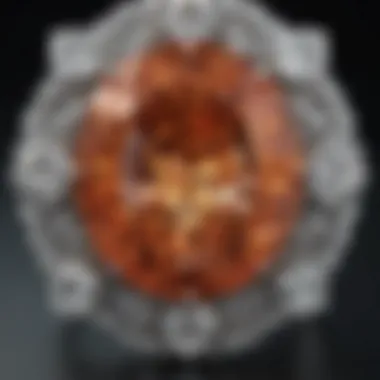
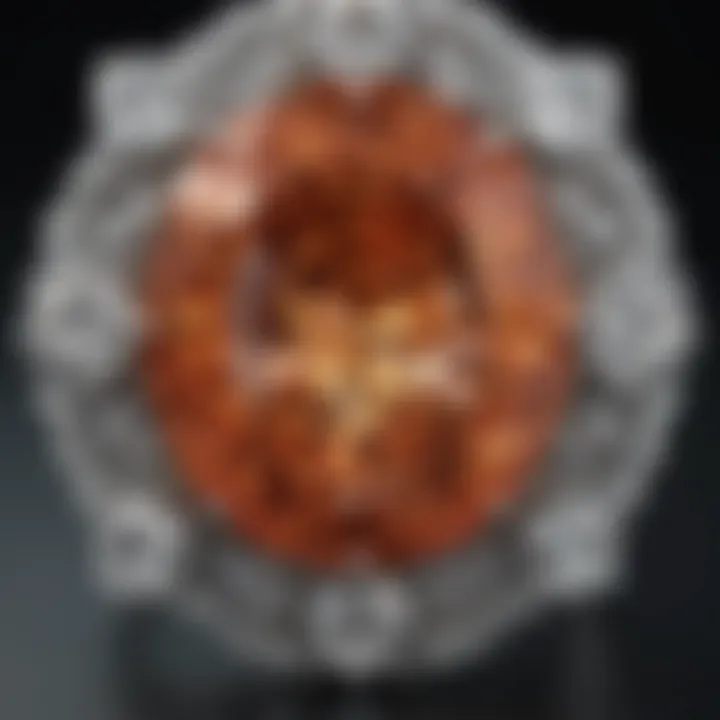
Market trends often provide a wealth of information regarding recent consumer behavior with diamonds. For instance, the preference between oval and round diamonds has shown fluctuations influenced by various factors:
- Celebrity Influence: Many couples are inspired by celebrity engagements. Rings sported by figures like celebrities can become the flagship designs. When a famous star opts for an oval diamond, it can create a ripple effect, leading to a rise in popularity for that shape.
- Social Media Impact: Platforms such as Instagram serve as visual catalogs. The hashtag #OvalEngagementRing has gained traction, as users share their love stories and preferred designs. A visually appealing photo can sway preferences in a heartbeat.
- Customization Trends: Increasingly, consumers are looking for unique designs. The value of personalized engagement rings has led many to choose custom settings, tailored to enhance the unique characteristics of oval or round diamonds.
Consumer Insights and Preferences
Delving into consumer insights brings clarity to how people make decisions surrounding their diamond choices. It’s not just about the stone they select, but the emotional and social contexts that inform their decisions. Consider the following:
- Emotional Connection: Many individuals attached significant meaning to their choice of diamond shape. For some, round diamonds symbolize tradition and timelessness, while oval shapes might represent uniqueness and creativity.
- Influence of Education: Awareness around the diamond's cut, clarity, and carat weight affects purchasing decisions. Investigating how these factors impact brilliance often persuades buyers toward one shape over the other.
- Buyer's Journey: The journey to find that perfect engagement ring can be lengthy and filled with research. According to studies, about 60% of buyers spend substantial time online before making their decision. They read reviews, check videos, and gather insights about what suits their partner's style best.
Through understanding these consumer trends and preferences, buyers can make informed decisions that honor both personal taste and the broader cultural context.
"An engagement ring isn't just a piece of jewelry; it's a symbol of commitment, a personal story, and a reflection of individual values."
Cost Considerations
When it comes to choosing between oval and round diamond engagement rings, understanding the cost implications is crucial. Different factors contribute to the pricing of each shape, which can ultimately influence buyer decisions. It's not solely about the choice of the diamond, but also how the specific shape affects overall values. Hence, when you're browsing through options, it's worth paying attention to these cost considerations to align your preferences with your budget.
Pricing Variables for Round Diamonds
The round diamond is often called the most classic choice and its popularity comes with its price tag. Here are some of the key pricing variables or factors to bear in mind:
- Brilliance and Cut: Round diamonds are typically cut for exceptional brilliance. Master cutters spend considerable time and skill to achieve this. As a result, the more precise the cut, the higher the price.
- Demand and Availability: Round diamonds reign supreme in market demand. Being the most purchased shape, this leads to increased market prices.
- Carat Size: The size of the stone heavily influences cost. Larger round diamonds can get pricey fast as they become rarer and more sought after.
In essence, if you are drawn to the allure of a round diamond, expect its price to reflect the cut’s extraordinary craftsmanship and high demand in the market.
Cost Factors for Oval Diamonds
While oval diamonds are emerging in popularity, their pricing structure differs from that of round diamonds. Investing in an oval shape can offer unique advantages:
- Price per Carat: Generally, oval diamonds are less expensive per carat compared to round diamonds. This can allow buyers to purchase a larger stone within the same budget.
- Cut Complexity: Although still needing skilled craftsmanship, oval diamonds may require less intensive precision than their round counterparts. This can also impact their pricing positively for buyers.
- Market Niche: Oval shapes are still gaining traction, so you might find variations in price based on market supply and personal seller demand.
"Choosing an oval diamond may give you more carat weight for the same price as a smaller round diamond, presenting a unique blend of beauty and value."
Overall, understanding these cost considerations helps potential buyers appreciate the financial aspects of their choice while ensuring they make a decision that aligns not only with their aesthetic preferences but also with their financial planning. It's all about finding that right balance.
Durability and Maintenance
When it comes to choosing an engagement ring, the durability and maintenance of diamonds can be overlooked. For both round and oval diamonds, understanding the wear and tear they might face in everyday life is essential. After all, this piece of jewelry is meant to symbolize a lifelong commitment.
Care Needs for Round Diamonds
Round diamonds are notorious for their brilliant sparkle, thanks to their precise cut. However, with shine comes the responsibility of proper care. Since the round shape has rounded edges, it can withstand impacts better than sharper-cut stones, which makes it a solid choice for someone with an active lifestyle. Nevertheless, regular cleaning is a must to maintain its gleam.
To keep a round diamond looking pristine:
- Cleaning Routine: A mixture of warm water and mild soap will do wonders. Soaking the ring for a short while, followed by a gentle scrub with a soft toothbrush, gets rid of any build-up.
- Regular Inspections: Checking the prongs and settings helps ensure the diamond is secure. Missing prongs can lead to losing the stone, which no one wants to experience.
- Professional Cleanings: Visiting a jeweler every six months for a professional cleaning can truly bring back the bling. They also check for any repairs needed that you might miss.
Maintaining the Integrity of Oval Diamonds
Oval diamonds, although stunning, come with their own set of considerations when it comes to durability. The elongated shape may be more prone to chipping than round ones because of the higher number of pointed edges. However, many find that the unique shape and appearance often outweigh these concerns.
To keep your oval diamond in top form, consider the following:
- Avoiding Hard Impacts: Try to avoid activities that can cause the ring to hit hard surfaces. When doing rough tasks, it's wise to remove the ring and put it in a safe space.
- Gentle Cleaning: Similar to round diamonds, using a soothing soap solution and a soft brush can keep oval diamonds shining bright. That said, one should be careful not to scrub too hard near the edges to avoid any accidental damage.
- Regular Check-Ups: Just like with round diamonds, keep up with regular inspections and maintenance visits to a jeweler. They can ensure that the diamond is still securely set and that any wear and tear has been managed properly.
"A diamond's beauty isn't just surface deep; its care determines how it withstands the test of time."
In summary, both round and oval diamonds have distinct maintenance needs, but each can shine brightly with proper attention. Remember, it’s all about loving and taking care of that special piece, knowing it’s a representation of a beautiful bond.
Closure: Choosing the Right Shape
In the world of engagement rings, the shape of a diamond plays a pivotal role. It’s not merely about aesthetics; it’s a blend of personal style, cultural significance, and the emotional connection one feels towards a specific design. Both oval and round diamonds have their charm, but the choice between them can profoundly affect the overall look and feel of the ring.
When pondering on the right shape, several key elements come into play:
- Personal Taste: What resonates more? The classic allure of a round diamond or the modern elegance of an oval? Understanding your tastes is essential as it forms the basis for your choice.
- Occasion and Lifestyle: Engagement rings are often worn daily, so it's important to consider the practical aspects too. For instance, some women prefer the rounded edges of a round diamond for its durability, while others might choose an oval for its uniqueness.
- Visual Impact: Think about how each shape enhances light reflection. Round diamonds are often regarded for their unmatched brilliance and fire, while oval diamonds can create an illusion of greater size, something many find appealing.
Additionally, the settings and styles in which these shapes can be set offer further versatility. A round diamond may fit seamlessly into a traditional solitaire setting, whereas an oval might shine best in a vintage or contemporary band setting.
Final Thoughts on Round vs Oval
Choosing between a round or an oval diamond can feel like walking a tightrope, balancing on the edge of emotion and logic. Round diamonds have stood the test of time, becoming the quintessential engagement ring choice. They symbolize everlasting love and are often seen as the traditional option. Meanwhile, oval diamonds exude a charm of their own; they represent a break from convention, offering a unique silhouette that speaks to individuality.
Before making a decision, it’s crucial to reflect on the qualities that matter most to you. Consider taking the time to visit a jeweler, examining the pieces up close. Holding a round diamond against your skin may evoke a different response than trying on an oval.
At the end of the day, both shapes are equally precious and can signify a beautiful commitment. The right choice is one that encapsulates not just aesthetic appeal but personal sentiment. As you embark on this journey of selection, remember that this ring will be a symbol of love, crafted to carry memories and stories as it adorns a finger for years to come.
"The best engagement ring isn’t just about the diamond; it's about what it represents."
Ultimately, be true to yourself—choose the shape that speaks to your heart.



